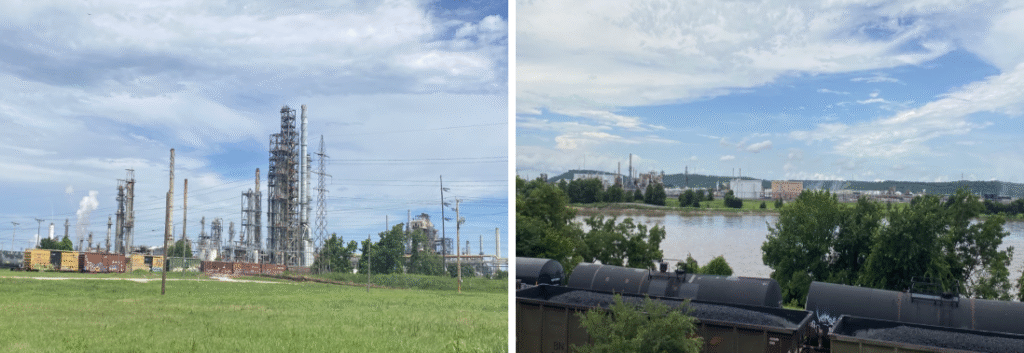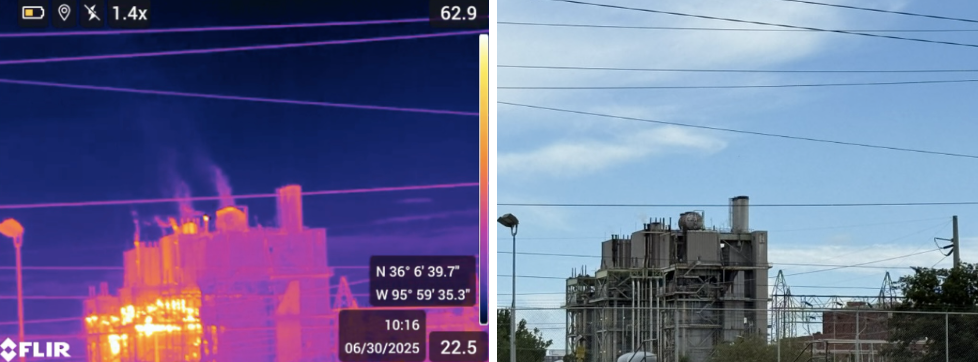“The absence of data isn’t the same as absence of risk.”
Tulsa, Oklahoma has a strong connection with the oil and gas industry. The city established itself as an important hub for oil investments and production in the early 1900’s. Tulsa earned the title as “oil capital of the world” in 1905, before it was even a state. A title that remained until the early 1970’s. The discovery of oil reserves in the region by the Sinclair Oil and Gas Company in 1916 attracted many companies and influenced economic growth. Tulsa was now a boomtown.
Today, a few industrial sites still contribute to this legacy-the HF Sinclair Refinery at 1700 S. Union Ave, and the Public Service Company of Oklahoma (PSO) power stations situated at W Trail River Parks. While these sites contribute to the local economy, they also contribute to air and water pollution with respect to the Arkansas River, an important water resource for both people and local ecosystems.
HF Sinclair Refinery: A Historic Facility With a Troubled Past

Photos taken by Kelsey Royce of Tulsa Area Arkansas River Advocates
The HF Sinclair Refinery was built in 1916, evolving into a prominent refinery that processes large volumes of crude oil. However, its long history is not without controversy. Over the decades, the facility has faced Clean Air Act violations, OSHA violations, admitted to environmental crimes, knowingly manipulating refinery processes, wastewater flows, and wastewater discharges, including exceedances of allowable limits for volatile organic compounds (VOCs) and sulfur dioxide (SO2) (Ragothaman & Anderson, 2017; , Al‐Rubaye et al., 2023). You can learn more about these crimes, here. Residents living near the refinery frequently express their concerns regarding potential contamination of the Arkansas River, emphasizing the need for safeguards to protect the community and its natural resources.
Environmental advocacy group Oilfield Witness has documented emissions from the refinery using an optical gas imaging camera. This camera can detect specific wavelengths of light emitted by gases, allowing for the visualization of emissions that are invisible to the human eye. This technology serves as a tool for monitoring compliance with environmental regulations and holding facilities accountable by exposing their pollution.
The emissions from the HF Sinclair Refinery pose risks to air quality and public health. Pollutants such as particulate matter, nitrogen oxides, and VOCs can contribute to respiratory illnesses and other health issues among locals (mohammed & Rabee, 2021). Moreover, concerns about the cumulative effects of emissions from the refinery and other nearby facilities highlight the necessity for monitoring solutions and regulatory practices to meaningfully protect the community (Malin et al., 2024).
Energy Generation and Environmental Impact
The PSO power stations located at W Trail River Parks play an important role in providing electricity to Tulsa. However, these plants have faced criticism regarding their environmental impact. Increasing community concerns focus on emissions of greenhouse gases, sulfur dioxide, nitrogen oxides, and particulate matter that can degrade air quality and contribute to health problems in the surrounding population (Rishack et al., 2013).
As with the HF Sinclair Refinery, Oilfield Witness has conducted monitoring using optical gas imaging technology to document emissions from PSO’s facilities. The ability to visualize gas releases can increase accountability and improve adherence to environmental standards. Local residents have reported adverse effects from these emissions, including unpleasant odors and respiratory complications (Yao et al., 2011). The cumulative effect of emissions from multiple industrial sources in the area warrants further investigation to determine the overall impact on public health, and the Arkansas River ecosystem.

Optical Gas Image of emissions from PSO power station along the Tulsa area Arkansas River
How to Move Forward: Addressing Community Concerns
Organizations like the Tulsa Area Arkansas River Advocates (TAARA) are actively advocating for stricter regulations and greater transparency in emissions reporting from these facilities. The implementation of advanced monitoring technologies, such as optical gas imaging cameras and comprehensive air and water monitoring systems, is crucial for ensuring compliance, safeguarding our environment, and protecting public health.
As Kelsey Royce, a local resident, TAARA member, and dedicated advocate for the Arkansas River and Tulsa community, eloquently stated during a 2023 city council meeting concerning water quality, “The absence of data isn’t the same as absence of risk.” This sentiment underscores the critical importance of data collection and public access to information.
While both the HF Sinclair Refinery and PSO power stations contribute to the local economy, their operations have environmental implications that need to be addressed. Continued community advocacy, regulatory oversight, and advanced monitoring technologies are essential to mitigate pollution risks and safeguard public health and natural resources in Tulsa, Oklahoma.
References
- Ragothaman, and Anderson. “Air Quality Impacts of Petroleum Refining and Petrochemical Industries.” Environments (2017). doi:10.3390/environments4030066.
- Al–Rubaye et al. “The Side Effect of Oil Refineries on Environment: As a Mini Review” Iop Conference Series Earth and Environmental Science (2023). doi:10.1088/1755-1315/1262/2/022024.
- Malin et al. “‘You fine an industry, then return the funding to them’: State-facilitated corporate crime and Colorado’s Suncor Oil Refinery.” Sociological Forum (2024). doi:10.1111/socf.13039.
- Mohammed and Rabee. “Evaluation of Biomarkers in Workers Exposed to Air Pollutants in Oil Refineries.” Indian Journal of Forensic Medicine & Toxicology (2021). doi:10.37506/ijfmt.v16i1.17494.
- Messer, C. M., Shriver, T. E., & Adams, A. E. (2018). The destruction of black wall street: tulsa’s 1921 riot and the eradication of accumulated wealth. The American Journal of Economics and Sociology, 77(3-4), 789-819. https://doi.org/10.1111/ajes.12225
- (2021). Buck colbert franklin: “the tulsa race riot and three of its victims”. Schlager Anthology of Black America. https://doi.org/10.3735/9781935306627.book-part-155
- Кларк, К. (2021). Addressing systemic racial injustice in the united states from the war on poverty to social enterprise to black lives matter. The Journal of Social Policy Studies, 19(1), 143-154. https://doi.org/10.17323/727-0634-2021-19-1-143-154
- Brophy, A. L. (2002). Reconstructing the dreamland: the tulsa riot of 1921.. https://doi.org/10.1093/oso/9780195146851.001.0001
- Yao et al. “Design of Building PV Power Station Data Transmission and Monitoring System Based on ZigBee.” Applied Mechanics and Materials (2011).doi:10.4028/www.scientific.net/amm.121-126.1259.
- Rishack et al. “Modeling of Pollutants Prediction from Fuel Burning in Oil and Gas Refineries.” Engineering and Technology Journal (2013). doi:10.30684/etj.2013.83716
- Reinschmidt et al. “Pre-Pandemic Landscape of the Oklahoma Public Health Workforce: A Case Study From the Region 6 Training Needs Assessment Survey, 2019.” Journal of Public Health Management and Practice (2024). doi:10.1097/phh.0000000000001966.